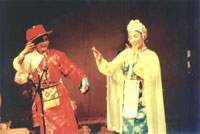
Tibetan Opera is an ancient art form that has developed over the centuries. The Tibetan people have long cherished this important aspect of their folk culture and it has become part of who they are. Indeed, wherever you find Tibetan people, you find Tibetan opera.
Almost all of China’s 55 ethnic minorities have their own operas. The one you’re now listening to heralds from the highest plateau in the world—Tibet. The simple but passionate rhythm contains both songs of joy and songs of sorrow.
Throughout the ages Tibetan opera has played a central role in the life of the Tibetan people. Every August and September, hundreds of thousands of Tibetan people put on their best clothes, and come together to watch Tibetan Opera in the bright sunshine.
Tibetan opera is one of the most ancient operas in China. There is a beautiful legend about its beginnings. In the 14th century, there was a ruler named Tangdongjiebu. To help his people, he planned to build an iron bridge over every river in Tibet. However, he needed a lot of money so he traveled around Tibet and trying to raise the necessary funds. However, after three years of wandering he still couldn’t finance his bridges.
However, his efforts caught the attention of a goddess in Heaven. In one of his dreams, the goddess guided him towards seven beautiful sisters who danced very well. Tangdongjiebu organized them into a dancing troupe to hold performances in different places to earn money for his bridges. This is believed to be the birth of Tibetan Opera. Tibetan opera became known in the local language as Ajilamu, meaning fairy sisters. Tangdongjiebu himself is considered as the father of Tibetan opera.
In the early years, Tibetan Opera mainly involved miming simple stories of local life. Overtime, local folk artists demonstrated their versatility in gradually transforming the opera into a unique art with strong national features.
Zhaxi is Director of the Tibetan Opera Troupe of the Tibetan Autonomous Region.
“As the opera matured it became increasingly complex in structure, containing many literary strands. The stories in the depicted are very beautiful. It has also absorbed many local dances and other art forms. There is always a light-hearted humour in it that appeals to audiences.”
Tibetan Opera is important in the life of the local people. The opera features prominently in a number of Tibetan festivals, some of which have been specifically designed for it. For instance, the Sour Milk Drinking Festival, or Xuedun Festival in Tibet, is directly linked to operatic performances.
The Xuedun Festival began in the 11th century. Originally it was a religious summer festival that involved people gathering together and drinking sour milk. In the 17th century, Tibetan opera was introduced into the ceremonies. It is now essentially a stage for the performance of Tibetan Opera. In fact, the event has also become known as the Tibetan Opera Festival, although there is still plenty of sour milk drinking.
Historically, these operatic performances were reserved for those of high social status. Today it is open to all and is close to the life of ordinary people. In many parks, a wide cross-section of people gather to enjoy the performances. Tourists can also join the audience, and taste the fragrant Qingke Barley Beer and delicious mutton.
Tibetan Opera is also becoming increasingly recognized in other parts of China and beyond. Basang, is an actress with the Tibetan Opera Troupe .
“The Tibetan Opera has a very large audience, not only in Tibet, but in other parts of China and across the world. Although many of the audience can’t understand the lyrics, they can understand the performances through the dances and the singing. I’m optimistic about the future of Tibetan Opera.”
Fortunately, it would appear that the future is bright for this beautiful art.
